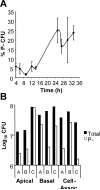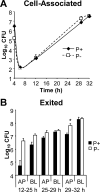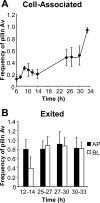Gonococci exit apically and basally from polarized epithelial cells and exhibit dynamic changes in type IV pili
- PMID: 16922862
- PMCID: PMC2290004
- DOI: 10.1111/j.1462-5822.2006.00722.x
Gonococci exit apically and basally from polarized epithelial cells and exhibit dynamic changes in type IV pili
Abstract
Type IV pili are a major virulence factor of the obligate human pathogen Neisseria gonorrhoeae (the gonococcus; Gc). Pili facilitate bacterial adherence to epithelial cells, but their participation in later steps of epithelial infection, particularly intracellular replication and exit, is poorly understood. Using polarized T84 cells as a model for mature mucosal epithelia, pilus dynamics in piliated, Opa-expressing Gc were examined over time. T84 infection was characterized by a several-hour delay in the growth of cell-associated bacteria and by non-directional exit of Gc, the first time these phenomena have been reported. During infection, non-piliated progeny arose stochastically from piliated progenitors. Piliated and non-piliated Gc replicated and exited from T84 cell monolayers equally well, demonstrating that piliation did not influence Gc survival during epithelial infection. The frequency with which pilin variants arose from a defined piliated progenitor during T84 cell infection was found to be sufficiently high to account for the extensive pilin variation reported during human infection. However, the repertoire of variants appearing in association with T84 cells was similar to what was seen in the absence of cells, demonstrating that polarized epithelial cells can support Gc replication without selecting for a subset of pilin variants or piliation states.
Figures





Similar articles
-
Pseudomonas aeruginosa Type IV pilus expression in Neisseria gonorrhoeae: effects of pilin subunit composition on function and organelle dynamics.J Bacteriol. 2007 Sep;189(18):6676-85. doi: 10.1128/JB.00407-07. Epub 2007 Jun 15. J Bacteriol. 2007. PMID: 17573479 Free PMC article.
-
CD46-independent binding of neisserial type IV pili and the major pilus adhesin, PilC, to human epithelial cells.Infect Immun. 2005 May;73(5):3072-82. doi: 10.1128/IAI.73.5.3072-3082.2005. Infect Immun. 2005. PMID: 15845515 Free PMC article.
-
The PilC adhesin of the Neisseria type IV pilus-binding specificities and new insights into the nature of the host cell receptor.Mol Microbiol. 2005 May;56(4):945-57. doi: 10.1111/j.1365-2958.2005.04600.x. Mol Microbiol. 2005. PMID: 15853882
-
Type IV pili of Neisseria gonorrhoeae influence the activation of human CD4+ T cells.Infect Immun. 2006 Jan;74(1):442-8. doi: 10.1128/IAI.74.1.442-448.2006. Infect Immun. 2006. PMID: 16369000 Free PMC article.
-
The role of pilin glycan in neisserial pathogenesis.Mol Cell Biochem. 2003 Nov;253(1-2):179-90. doi: 10.1023/a:1026058311857. Mol Cell Biochem. 2003. PMID: 14619968 Review.
Cited by
-
Pilus phase variation switches gonococcal adherence to invasion by caveolin-1-dependent host cell signaling.PLoS Pathog. 2013;9(5):e1003373. doi: 10.1371/journal.ppat.1003373. Epub 2013 May 23. PLoS Pathog. 2013. PMID: 23717204 Free PMC article.
-
Constitutively Opa-expressing and Opa-deficient neisseria gonorrhoeae strains differentially stimulate and survive exposure to human neutrophils.J Bacteriol. 2013 Jul;195(13):2982-90. doi: 10.1128/JB.00171-13. Epub 2013 Apr 26. J Bacteriol. 2013. PMID: 23625842 Free PMC article.
-
PacBio Amplicon Sequencing Method To Measure Pilin Antigenic Variation Frequencies of Neisseria gonorrhoeae.mSphere. 2019 Oct 2;4(5):e00562-19. doi: 10.1128/mSphere.00562-19. mSphere. 2019. PMID: 31578246 Free PMC article.
-
Phase variation leads to the misidentification of a Neisseria gonorrhoeae virulence gene.PLoS One. 2013 Aug 16;8(8):e72183. doi: 10.1371/journal.pone.0072183. eCollection 2013. PLoS One. 2013. PMID: 23977246 Free PMC article.
-
Folliculin Controls the Intracellular Survival and Trans-Epithelial Passage of Neisseria gonorrhoeae.Front Cell Infect Microbiol. 2020 Sep 4;10:422. doi: 10.3389/fcimb.2020.00422. eCollection 2020. Front Cell Infect Microbiol. 2020. PMID: 33014885 Free PMC article.
References
-
- Apicella MA, Ketterer M, Lee FK, Zhou D, Rice PA, Blake MS. The pathogenesis of gonococcal urethritis in men: confocal and immunoelectron microscopic analysis of urethral exudates from men infected with Neisseria gonorrhoeae. J Infect Dis. 1996;173:636–646. - PubMed
-
- Binnicker MJ, Williams RD, Apicella MA. Infection of human urethral epithelium with Neisseria gonorrhoeae elicits an upregulation of host anti-apoptotic factors and protects cells from staurosporine-induced apoptosis. Cell Microbiol. 2003;5:549–560. - PubMed
Publication types
MeSH terms
Substances
Grants and funding
LinkOut - more resources
Full Text Sources
Miscellaneous

